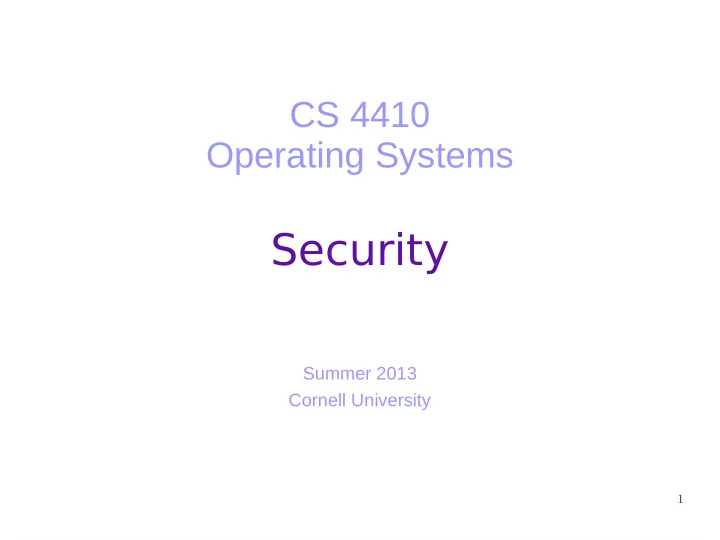

CS 4410 Operating Systems Security Summer 2013 Cornell University 1
Today ● How does the OS provide security? ● Secure System ● Security Violations ● Security Measures ● Threats ● User Authentication ● Protection 2
Secure System ● A system is secure if its resources are used and accessed as intended under all circumstances. ● But, total security cannot be achieved. ● We must have mechanisms to make security breaches a rare occurrence, rather than the norm. 3
Security Violations ● Breach of confidentiality ● Unauthorized reading of data. ● Breach of integrity ● Unauthorized modification of data. ● Breach of availability ● Denial of service 4
Program Threats ● Trojan Horse ● A code segment that belongs to an 'innocent' program. ● The user gets the program (cracked game or application) and installs it. ● While the program is being executed, the malicious code: – obtains user's privileges and – modifies/deletes user’s file, sends important info to cracker, etc 5
Program Threats ● Stack and Buffer Overflow ● It exploits a bug in a program: – The programmer neglects to code bounds checking on an input field. int A(argc, argv) { char buffer[BUFFER_SIZE]; if (argc < 2) return -1; else{ strcpy(buffer, argv[1]); return 0; } } 6
Program Threats ● Viruses ● A fragment of code embedded in a legitimate program or file. ● It corrupts/modifies files. ● They are incorporated in emails (spams) and infect the contacts of the user. 7
System and Network Threats ● Worms : ● Self-replicated malware program. ● It is spread through interconnected computers. ● It does not need to attach itself to an existing program. ● Harmful for the network. ● Denial of Service 8
Security Measures ● The protection of the system is split into four levels: ● Physical ● Human ● Operating System ● Network ● This chain is as weak as its weakest link. 9
User Authentication ● The ability of the system to identify each user. ● Major security problem for the OS. ● It is based on one or more of three things: ● The user's possession of something (a key/card). ● The user's knowledge of something (identifier/card). ● An attribute of the user (fingerprint, signature). 10
Protection ● Multiprogramming and timesharing OSes should define access rights (read, write, execute) that each process should have. ● Programs, users and even systems should be given just enough privileges to perform their tasks. ● Principle of least privilege ● The OS should define which access rights each process has for each object (hardware, software). 11
Protection The OS defines Protection Domains . ● Each domain defines a set of objects and the types of operations that may be ● invoked on each object. A domain is a collection of access rights . ● <object-name, rights-set> ● Ex. <fine_route.c, {read, execute}> ● Each process operates within a protection domain. ● D2 D3 D1 <O3, {read, write}> <O1,{execute}> <O1, {read, write}> <O2, {write}> <O4, {read}> <O3,{read}> <O2, {execute}> 12
Protection ● Access Matrix domain \ object F1 F2 F3 printer D1 read read D2 print D3 read execute D4 read read write write ● Implementation ● Global Table ● Access Lists for Objects ● Capability Lists for Domains 13
Today ● How does the OS provide security? ● Secure System ● Security Violations ● Security Measures ● Threats ● User Authentication ● Protection 14
Recommend
More recommend